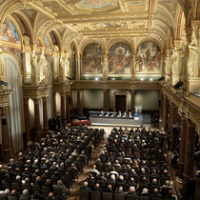Földünk a legkorábbi időkben – Stephen J. Mojzsis külső tag székfoglaló előadása
Stephen J. Mojzsis külső tag 2017. október 17-én megtartotta akadémiai székfoglalóját. Az előadás videóját képgalériával, magyar és angol nyelvű összefoglalóval közöljük.
Viták az élet eredetéről, kizárható elméletekkel
Az irányadó hipotézis szerint az élet törvényszerűen létrejön a szükséges négy összetevő jelenlétével: szerves anyagok, energia, folyékony víz és idő. Mindemellett fontos megjegyezni, hogy az alapfeltételek mellett is az élet első lépései a legnehezebbek. A 2007-ben elhunyt prof. Stanley Miller szerint „az élet eredete a darwini evolúció eredete”. Az ismeretek fényében a kijelentést úgy módosíthatjuk, hogy „az evolúció eredete az információ eredete”. A hádészi Föld, tehát kb. a Föld keletkezésétől, 4,57 milliárd évvel ezelőttől 3,85 milliárd évvel ezelőttig tartó időszak kéregösszlete jelentette a keretet az evolúció számára. Ahhoz, hogy megértsük, hogyan jött létre az élet, meg kell ismernünk a korai földköpeny és kéreg jellemzőit, átalakulását, a vízciklusra és a légkörre kifejtett hatását. A korai evolúciós lépések tisztázásához a fiatal Föld működését kell megértenünk, ehhez pedig az akkor kialakult kőzetek vizsgálata szükséges.
1. Earth’s primordial atmosphere was not fed by a more reduced mantle that in turn could have generated a “Prebiotic Soup”. Over the timescale of primary accretion, Earth-like mantles tend to become more oxidized via a combination of such things as metal sequestration in Fe-Ni cores, Fe-disproportionation and Si-partitioning in core growth, and the relatively late arrival of volatile-rich planetesimals. Hadean zircon Ce*/Ce compositions show that the mantle has been close to its present oxygen fugacity (buffered at FMQ) for the past 4.37 Gyr. As such, volcanic gases have long been dominated by CO2, H2O, SO2, N2 with minor H2.
 Stephen J. Mojzsis Fotó: mta.hu/Szigeti Tamás
Stephen J. Mojzsis Fotó: mta.hu/Szigeti Tamás2. Képgaléria a székfoglaló előadásról / Photogallery about the inaugural lectureDry land is a primordial phenomenon; Earth was never a pure Ocean-covered World. Work combining 147,146Sm-143,142Nd, 182W-184W, 176Lu-176Hf and 235,238U-207,206Pb on the oldest rocks places strict constraints on the longevity and residence time of Hadean crust. Model outputs show that the oceanic:continental dichotomy began ca. 4.45 Gyr, but what if its proportion (now ~2.4) was greater in the Hadean (~50)? Continental crust volume at 2% present translates to 10 Japan arcs. A more unimodal Hadean hypsometry means shallower average ocean depths of ~2 km and areas around ridge axes were subaerial (e.g. Sts. Peter and Paul archipelago), as would volcanic islands emerging above mantle plume heads (e.g. Hawai’I; Samoa, Iceland, Canary, Galapagos, Cocos). Doubling the hydrosphere hardly changes things. The above-mentioned landmasses exist now with an average ocean depth of 3.9 km.
3. Comets are an unsatisfactory source of water to Earth. Neither the Late Heavy Bombardment (LHB) nor the Late Veneer (LV) brought Earth’s oceans in the form of comets. Evidence exists for a hydrosphere well before the LHB. The cumulative delivered mass of the LHB was less than about 10-3 % of Earth’s mass. This is too little to account for the hydrosphere. If the odds of a comet striking Earth are around 1:106, something like 105 comets are required to account for one ocean’s worth of seawater. At least 1011 comets (~5 MÅ) have to be in the source region to explain one ocean volume. If Earth’s crust-mantle inventory holds about 10 ocean volumes, this leads to a cometary reservoir of 50 MÅ just to explain Earth. Mars and Venus make this idea even less feasible. Both, D/H and 15N/14N isotopes are a poor match for comets, but generally right for chondrite building blocks.
4. Subsequent to the LV, it is probably not possible to eradicate microbial life on Earth with bombardment. To do so requires that the whole surface be heated to sterilization (>130°) to depth all at once. Cooling times between large impacts (asteroids 300 km diameter) during the LHB were far shorter than the recurrence interval of individual large impacts. The oldest terrestrial rocks pre-date the terminus of the LHB. Evidence exists for both sedimentary rocks and a biosphere at LHB time.




